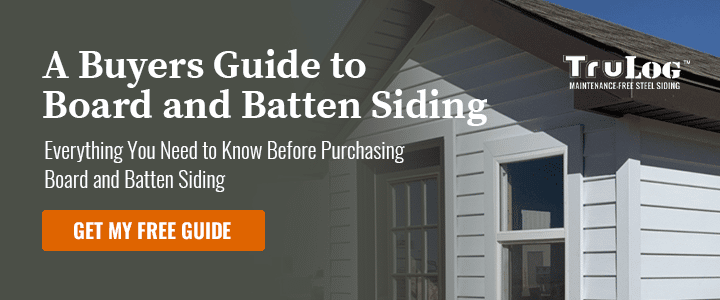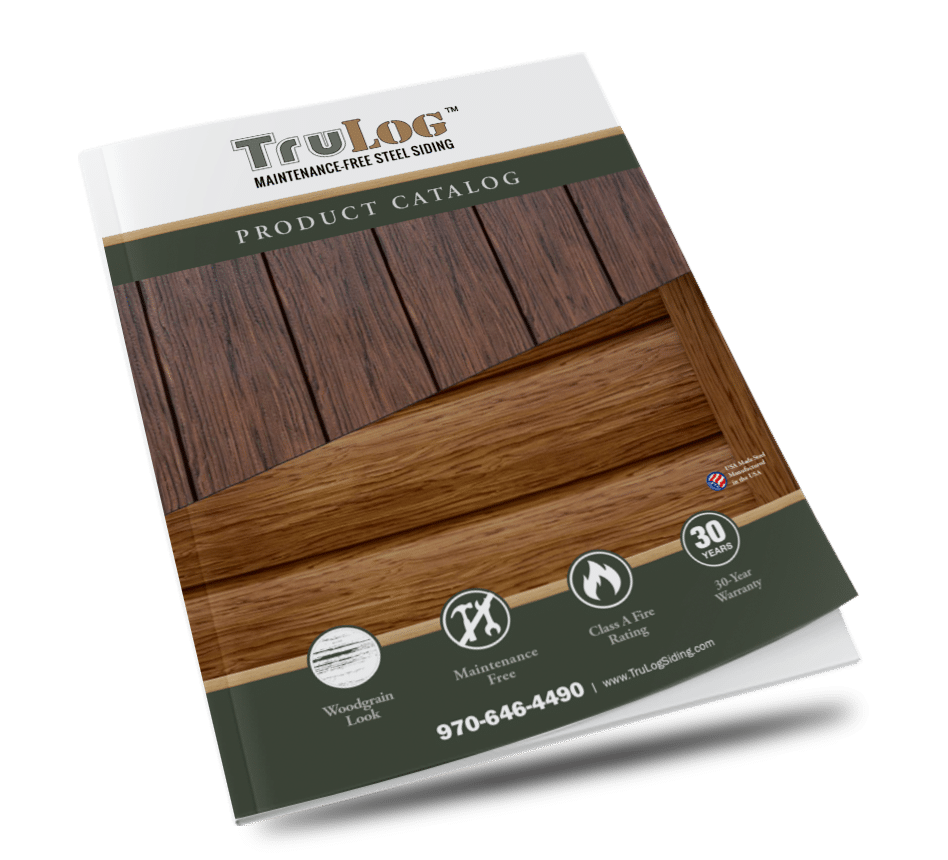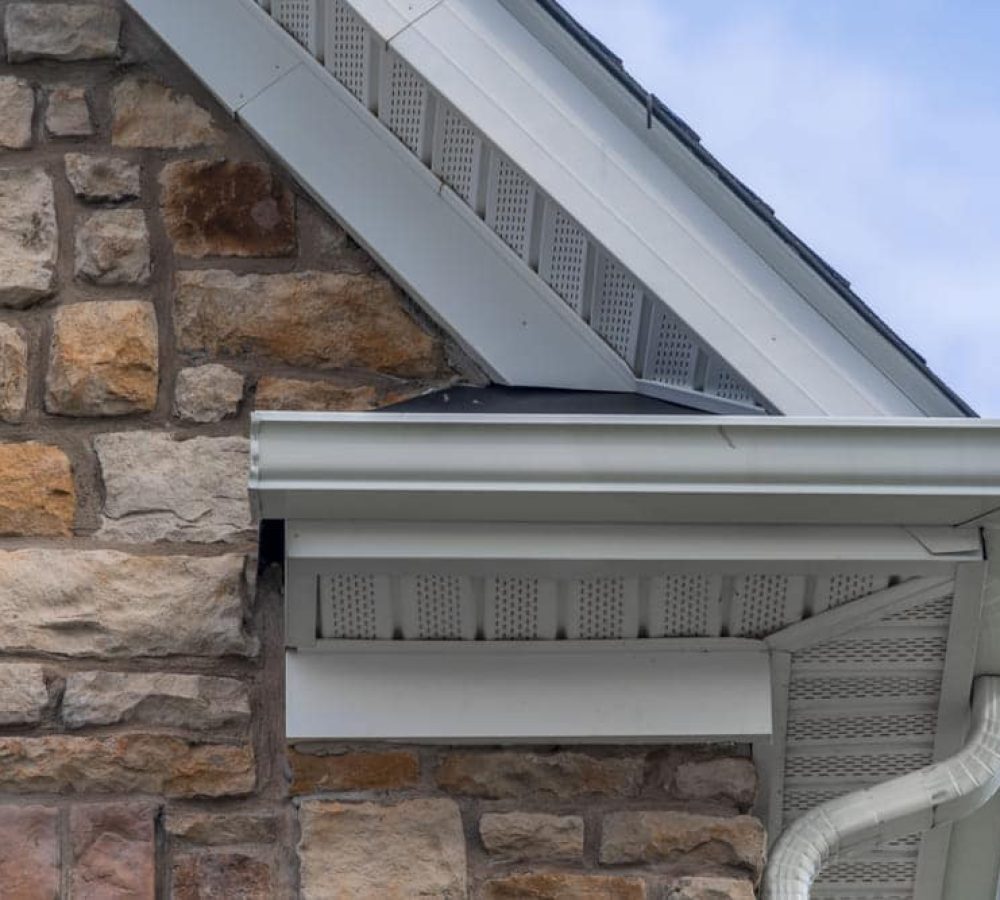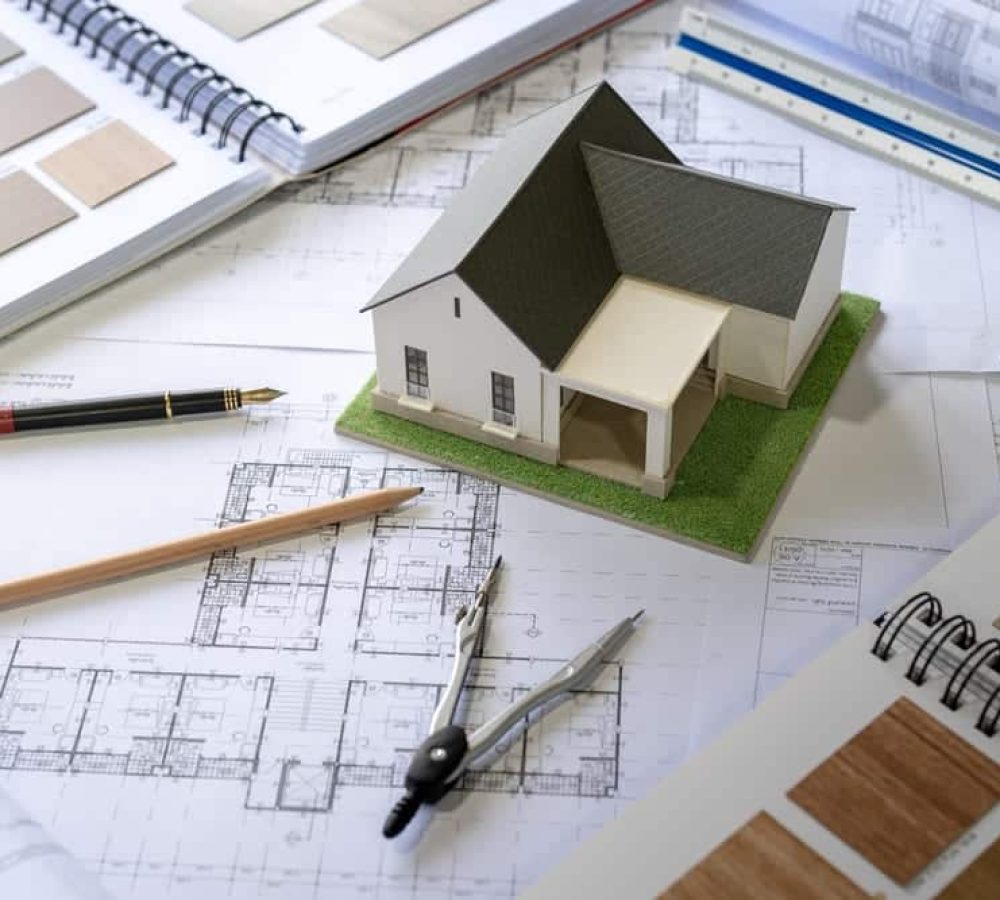Board and batten siding has been around for ages, but it has often been overlooked as a modern exterior choice. Recently, it has become one of the most popular siding choices around. Board and batten siding can be seen in new residential development projects and older home renovations alike. Appealing to many and timeless in its design qualities, board and batten siding is no longer boring or “outdated.”
As classic of a choice as it is, board and batten siding has actually seen great advancement in terms of product design and material use. More modern, innovative board and batten siding products offer longer-lasting protection and performance. Plus, many of these newer board and batten siding products are easier to maintain and don’t require the same amount of upkeep as traditional styles.
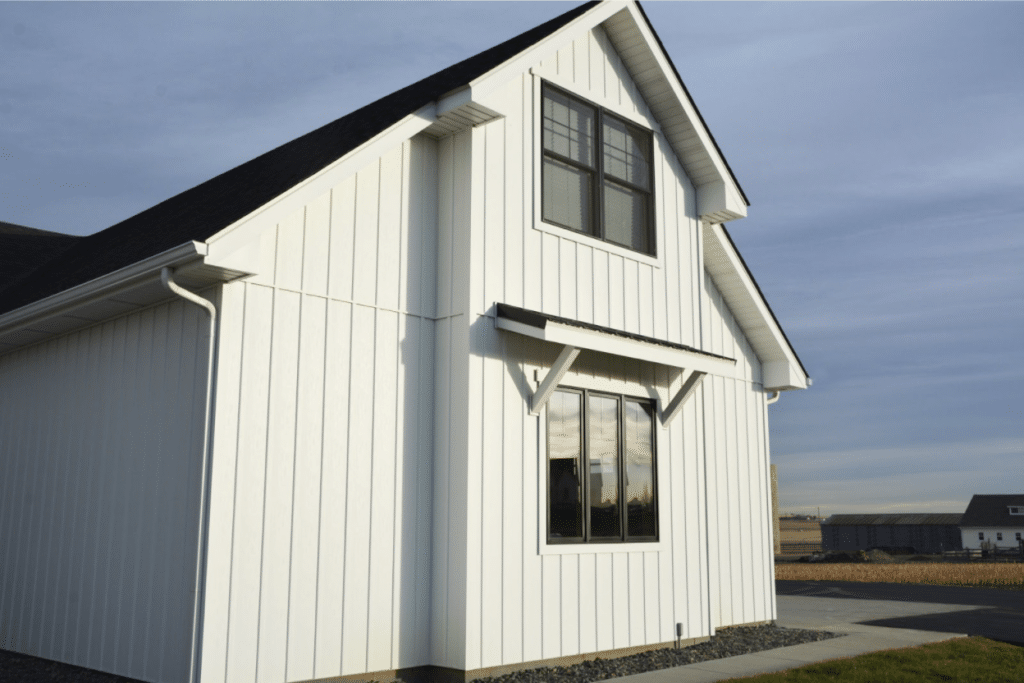
Not sure where to start when it comes to this popular siding style? Take a look at our extensive guide to board and batten siding before you begin project planning.
What is Board and Batten Siding?
Unlike horizontal lap paneling, board and batten siding is a vertical layout of panels designed to cover the exterior of a structure. Traditionally, board and batten siding consisted of super thin strips of wood secured vertically over the seams of larger boards, to create a textured exterior with an entirely vertical layout.
Nowadays, the textured effect of the board and batten design is the same, but it can be achieved using larger, seamless panels that recreate the battened look without all the unnecessary seams.

Board and batten is a type of wall cladding that features wide boards accompanied by strips of narrow wood that cover the seams. Historically, board and batten came about as a way to create a more energy-efficient structure that also benefits from the additional reinforcement achieved with the battens closing in the spaces between the larger beams. Nowadays, it is almost always chosen as a stylistic decision.
Board and batten can be applied both in the interior and exterior of the home. Interior paneling can be assembled with a board and batten layout, and some interior design trends have started suggesting board and batten as a unique way to create texture within a room. However, most board and batten designs remain on the exterior of the home, integrated into the layout of the siding.
Alternatively, some have even reinterpreted the technique by assembling board and batten horizontally for a fresh and surprising approach to exterior siding
The Historical Context of Board and Batten Siding
When sawmills started popping up in growing towns, milled boards were used for residential structures. Cut from local timber, milled boards were very long panels that could often reach from the foundation to the roof without the need for a horizontal seam in the middle.
Using horizontal log and beam structures instead of vertical siding became a smart way to build a good exterior relatively fast. It also had another advantage. Since every seam was essentially covered with an overlapping batten, the board and batten (sometimes colloquially referred to as “bat and board siding”) style produced fewer seams overall, meaning there was less opportunity for air to escape through the home’s exterior. In other words, board and batten siding proved to be a more energy efficient way of building structures.
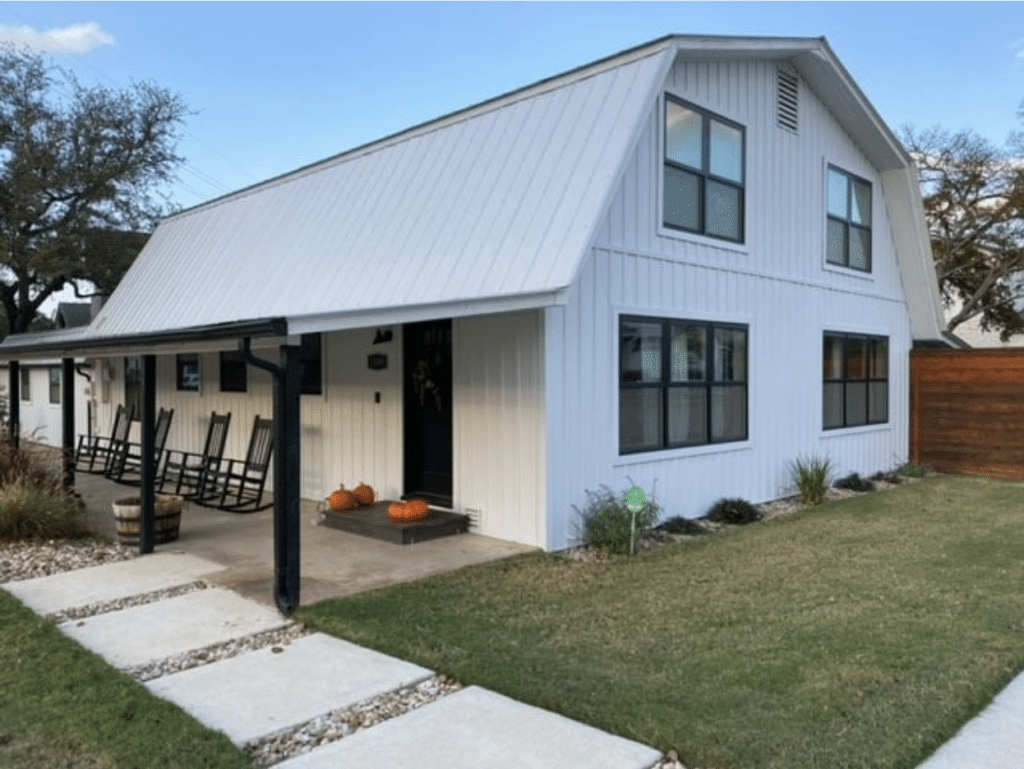
In addition to the historical benefits of board and batten, this design technique is now mainly used as a stylistic quality to give character to the home. Because many farmhouses were built in this style during the first half of the century, board and batten carries an aesthetic that is both rustic and chic, benefiting from the nostalgia of countryside farmhouse designs.
Aesthetic Design Opportunities with Board and Batten Siding
Like most architectural innovations, this new way of finishing building exteriors had an aesthetic appeal as well. The board and batten siding style quickly became an iconic look of frontier-style structures, and it grew in popularity because of its unique texture and vertical lines.
Today, board and batten siding is used in a variety of ways without appearing antiquated. The modern farmhouse style consistently uses board and batten siding as a key component of exterior layouts. Board and batten siding can also be seen in barndominiums, farmhouse revival, and mid-century modern homes. It’s also commonly used as an accent wall in transitional and contemporary architectural styles.
In addition to having a comfortable allure, board and batten is also used as a visual aid in helping a structure appear taller, wider or more expansive, depending on how the board and batten pieces are arranged.
Finally, the dimensional texture that is created with board and batten siding can create lovely light and shadow effects, which some find appealing.
Stylistic details are up to you, so use your creative eye to assess how the board and batten can flatter your home best!
Board and Batten Exterior Siding Materials
Board and batten siding is available in a variety of materials, each with different pros and cons
Wood
It’s no surprise that wood is the most traditional building material used for this exterior style. Though wood is still used today, it is not highly recommended because of its susceptibility to moisture damage, insect damage, flammability, and tendency to warp and sag due to changes in temperature. Wood board and batten siding often requires constant upkeep to maintain its strength and appearance.
The costs of utilizing wood for board and batten is between $3 and $10 dollars per square foot

Fiber Cement
Fiber cement is considered an upgrade from wood board and batten siding. Though it can be significantly more expensive, the cement component enhances the strength of the siding, allowing it to hold up better against the elements.
However, fiber cement board and batten siding still requires repainting to maintain the original color consistency. Repainting board and batten siding can be an exhaustive process, because the surface area is larger and more complex than flat siding. Another downfall of fiber cement siding is that it typically requires installation to be completed by a licensed professional, which can be costly.
The cost of utilizing fiber cement for board and batten averages $0.75 and $5 per square foot.
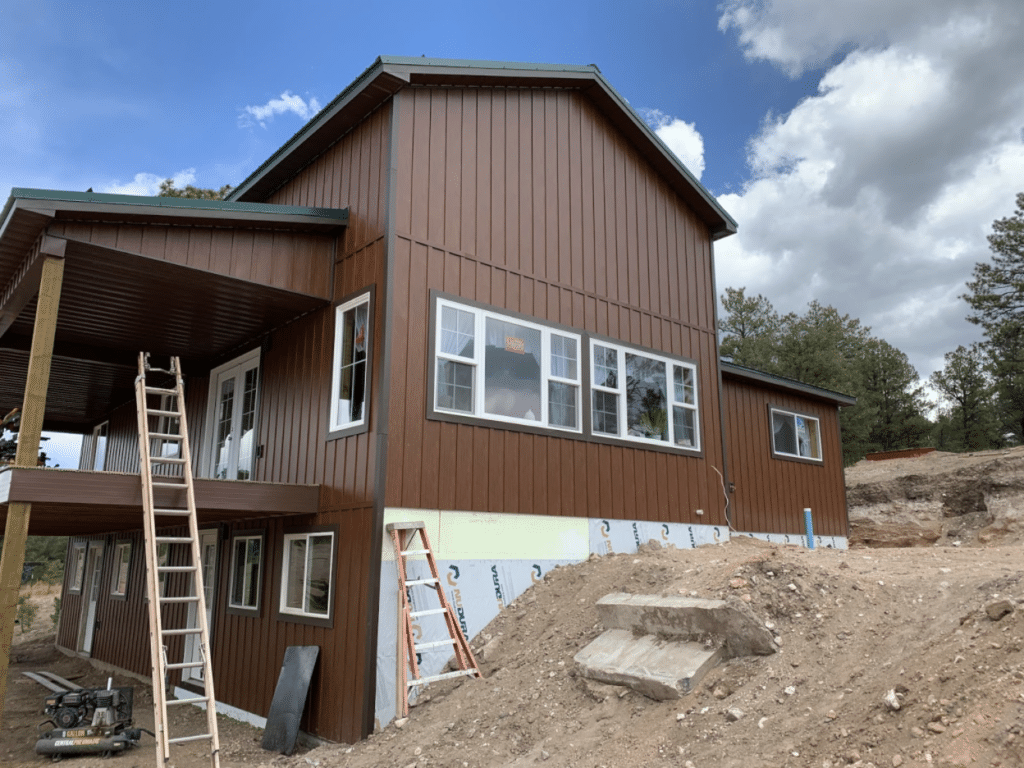
Steel
Steel board and batten siding is the most dependable option for homeowners who value long-lasting performance and little maintenance. Unlike wood and fiber cement, steel board and batten is very easy to install and can often be accomplished quickly by a general contractor. Steel board and batten is also a better choice in terms of fire safety, since metal won’t go up in flames the way wood siding will.
Heavy-gauge steel is also water-resistant, impact-resistant, and capable of protecting the home better, making it a great choice for board and batten siding. It’s designed to keep its original color consistency regardless of the elements, so steel board and batten siding does not need to be repainted as often as wood or fiber cement siding.
Due to the extreme dependability and durability of steel, costs are a bit higher at $3 to $8 per square foot.
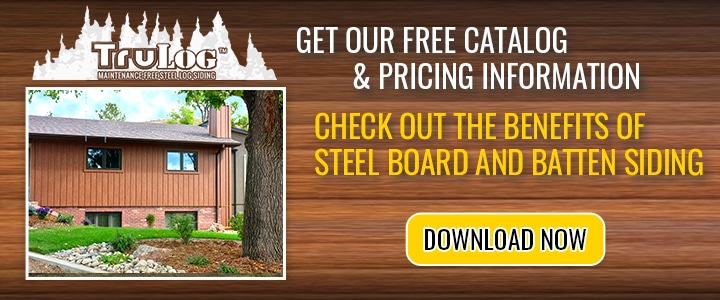
Engineered Wood
Engineered wood board and batten siding is another option to consider for homeowners looking for a low-maintenance alternative to traditional wood siding. This type of siding is made from a combination of wood fibers, resin, and wax, creating a durable and moisture-resistant material.
Engineered wood batten siding materials are often designed to mimic the look of natural wood, with a variety of textures and finishes available to choose from. This type of siding is also typically available in a range of pre-painted or stained colors, allowing homeowners to customize the look of their home and enhance its curb appeal.
One advantage of engineered wood board and batten siding is its ease of installation. The lightweight material can be easily cut and shaped on-site, making it a versatile option for a variety of architectural styles. The panels are typically designed with an interlocking system that allows for a seamless appearance and helps prevent water infiltration. Additionally, engineered wood batten siding materials are resistant to rot, insects, and decay, making them a low-maintenance and long-lasting option for homeowners.
Overall, engineered wood board and batten siding can be a great option for homeowners looking for a low-maintenance alternative to traditional wood siding. With a variety of textures, finishes, and colors available, this type of siding can enhance the curb appeal of a home while providing long-lasting durability and protection. When considering this type of siding, be sure to research different materials and installation methods to ensure the best results for your project
Vinyl Siding
Vinyl board and batten style siding is a popular choice for homeowners who want a low-maintenance and cost-effective option for their home’s exterior. This type of siding is made from polyvinyl chloride (PVC) resin, making it lightweight, durable, and resistant to rot, insects, and moisture.
Vinyl board and batten style siding is available in a range of colors and finishes, including wood grain patterns, and can be easily customized to enhance a home’s curb appeal. Additionally, the interlocking panels are designed to provide a seamless appearance while helping to prevent water infiltration, making vinyl board and batten style siding a reliable and long-lasting option for homeowners.
Board and Batten Siding Installation
The installation of board and batten siding can vary depending on the materials being used. By far the most labor intensive, wood board and batten siding will require a lot of time, effort, and expertise since each individual board and each individual batten will need to be lined up properly and secured in place.
This is not the case with more modern board and batten siding products, like those made from steel. In fact, steel board and batten siding is sold in large panels that include the board and batten in a single piece. The edges feature a nail strip and bottom lock to simplify the entire process. The smart design lets contractors line up the panels in place much faster and with more confidence, and it’s easy to tell when the panels snap into place correctly.
Steel board and batten siding installation can be accomplished quickly and with greater accuracy than traditional board and batten construction. As with any building project, correct installation can help the product perform the way it’s designed to and avoid malfunction and deterioration down the line. This means that homeowners can expect to save time, money, and effort right out of the gate!
Choosing the Right Board and Batten Siding Color
One thing to keep in mind with batten board exterior siding options is that it may need to be repainted down the line, especially when building with wood. Covering dark-colored siding with a lighter color may require extra effort and planning.
Likewise, if you want to keep the same color, be sure to save the exact details and color codes. Most siding materials will need to be repainted at some time down the line to correct minor wear and tear and general deterioration due to color fading and Sun damage. The exception to this is steel siding, which is designed to keep its color consistency year after year with little to no maintenance.
Choosing the right color of board and batten siding truly depends on the design style that the homeowner is trying to achieve. White board and batten siding is a fantastic choice for modern styles, like farmhouse-inspired exteriors and barndominiums.
Natural wood colors are also quite popular for board and batten siding. Walnut, ash, cherry, and cedar are consistent favorites, and the woodgrain patterning can add extra character and visual texture to the home’s exterior.
The beauty of choosing a modern building material like steel is that you can achieve the look of natural wood — including color tones and woodgrain — but with the enhanced strength and durability of metal. Steel board and batten siding is sold in a wide range of colors, affording homeowners lots of choice when it comes to designing their home’s fresh exterior.
Once a color is selected for board and batten siding, it’s important to choose an appropriate trim color or accent color that will be featured in other parts of the exterior, including the roofing, shutters, entryway, garage door, and other notable features. Creating contrast by using a crisp white trim or dark black trim is a great way to emphasize architecture and will help the vertical layout of board and batten siding appear more contained and intentional.
When deciding between board and batten or lap siding, homeowners need to have some important questions answered. Is board and batten more expensive than lap siding? Which one holds up longer? Which one requires more maintenance?
To make the best siding choice for your home, it’s helpful to compare the options side by side, including the pros and cons, costs, installation, and maintenance. As you’ll see, the distinguishing factor isn’t always the style of siding, but the quality of the materials used that makes the biggest difference.

Board and Batten vs Lap Siding
Costs
Board and batten siding can cost anywhere from $1 to $9 per square foot. Why the huge range? It all depends on the material selected. Wood and vinyl fall on the cheaper end of the spectrum, while fiber cement and steel tend to be slightly more expensive.
Though affordability may tempt homeowners to go with a cheaper material, remember that the price point often reflects the performance, which can make a more expensive product, like steel, considerably more valuable in the long run.performance, which can make a more expensive product, like steel, considerably more valuable in the long run.
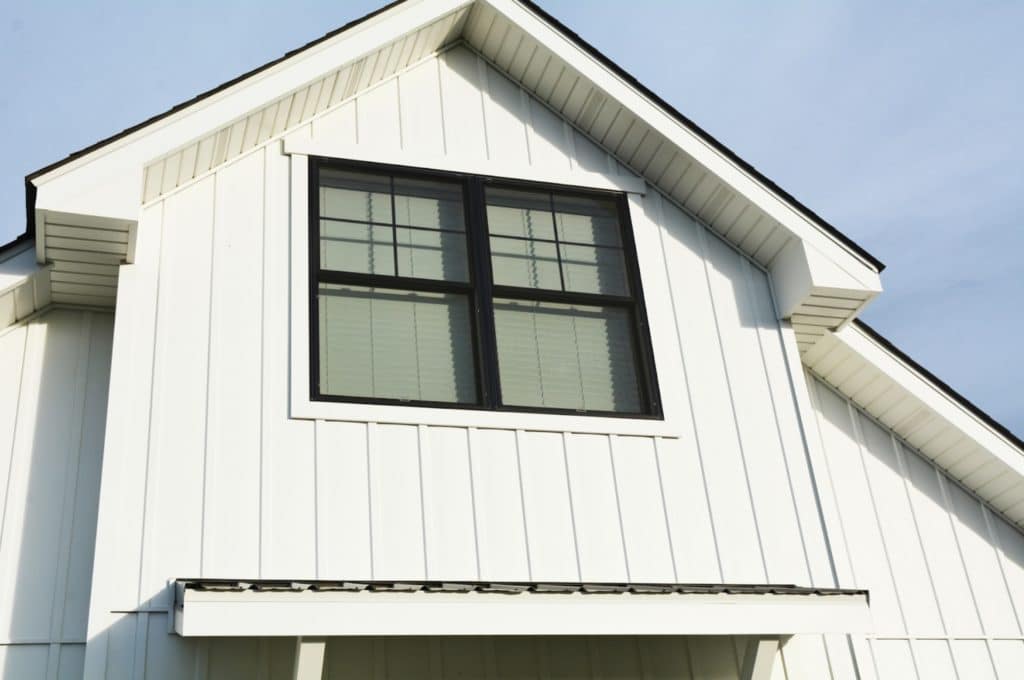
As with board and batten, lap siding has an extreme range when it comes to cost, depending on the material chosen. Lap can cost anywhere from $1 to $10, with soft woods costing the cheapest. Labor costs can also vary, depending on the style of lap selected. Remember, there’s more than basic lap siding — Dutch lap, clapboard, bevel, and shiplap may cost extra, depending on how a contractor assesses the workload.

Installation
Traditional installation techniques can be extensive for board and batten siding, which requires thin battens to be secured along every vertical seam between wider boards. The sheer amount of fixed points — and ensuring that all beams are uniformly level and lined up — can mean board and batten installation takes longer than lap.
That’s why many homeowners prefer to go with an innovative siding provider that simplifies board and batten installation. TruLog provides preformatted board and batten panels that are essentially based on a lock-in installation model. The battens and boards are one and the same, making installation an entirely easy task that can be completed much faster.

Lap siding is fairly easy to install, though the material choice can complicate things, too. Heavier siding materials, like fiber cement, can often require specialized tools and multiple people for adequate installation. The style of lap may create extra work for contractors.
That’s the great thing about going with a preformed, lock-in lap panel, like those made by TruLog. They feature a bottom lock and nail strip as part of the lap board, which simplifies the entire installation process and makes it an easy task that most can accomplish without issue. Since the preformed lap panels lock into place, it’s also much more difficult to make mistakes during the installation process!
Maintenance
Repainting may be necessary with wood or vinyl board and batten due to color fading from sun exposure, and wooden board and batten exteriors may require sanding and beam replacement due to rotting, chipping, or heat-warped panels. Wood-look steel siding is built to withstand the elements, so it remains entirely maintenance-free for the duration of its lifespan.
The maintenance involved in lap siding depends heavily on the material chosen. Wood and vinyl are likely to require painting down the line, which is much easier to accomplish on lap siding than it is on board and batten. Materials like steel, on the other hand, are designed to be maintenance-free.
Board and Batten Siding Pros and Cons
Board and batten siding has been around for a long time — and for good reason. It has a particularly timeless aesthetic that makes it a versatile choice. From countryside cottages to suburban homes, board and batten looks great in any setting.
Another benefit of this style of siding is that it has great resale value, mostly because of its timeless appeal. Many find the vertical layout of the siding to be charming, meaning it shouldn’t be difficult to attract potential buyers down the line.
With that said, board and batten does require a bit more labor during installation — that is, if a contractor is using a traditional installation technique rather than a modern, preformed board and batten style. Due to the increased surface area from the battens, this style of siding is more difficult to paint. Care must be taken to ensure that it’s covered completely. Repainting is only necessary when using a traditional material, like wood, which becomes irrelevant when selecting a modern, maintenance-free version of board and batten, like steel.
Lap Siding Pros and Cons
Lap siding creates an iconic residential charm, making it popular in suburbs, cities, and rural areas. In comparison with board and batten, one of the benefits of lap siding is that it is much easier to install when using traditional techniques. It can also be installed and repainted quicker than traditional board and batten.
Really, the stylistic difference is the only notable feature when comparing lap siding with board and batten, and many people don’t actually consider it a disadvantage. Lap siding is a bit more common and subdued in style than board and batten, meaning it may not be as eye-catching. However, there are lots of people who prefer the simplicity of lap siding.
The Long-Term Value of Board and Batten Siding
Board and batten siding is showing no signs of slowing down when it comes to desirability and use in new design styles. It’s a valuable style that is here to stay!
No matter what approach you take to board and batten siding design, it’s important to build with a material that will perform well and look great years later. For this reason, steel is an excellent choice of material that can make your board and batten siding last a long time and maintain excellent value.


